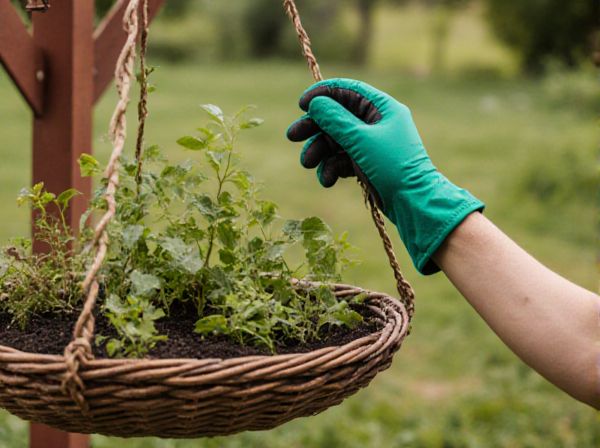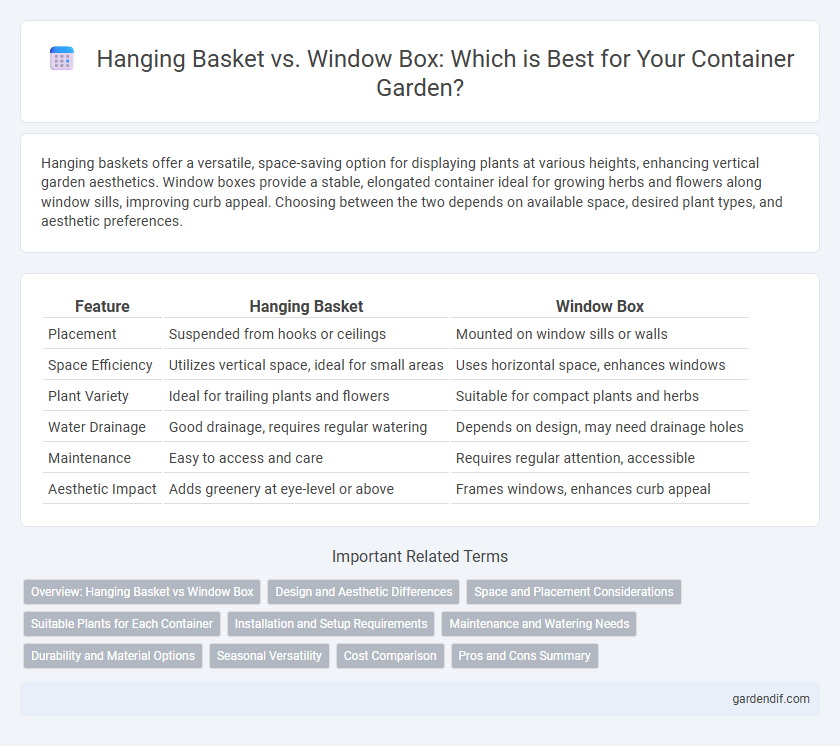
Hanging Basket vs Window Box Illustration
Hanging baskets offer a versatile, space-saving option for displaying plants at various heights, enhancing vertical garden aesthetics. Window boxes provide a stable, elongated container ideal for growing herbs and flowers along window sills, improving curb appeal. Choosing between the two depends on available space, desired plant types, and aesthetic preferences.
Table of Comparison
| Feature | Hanging Basket | Window Box |
|---|---|---|
| Placement | Suspended from hooks or ceilings | Mounted on window sills or walls |
| Space Efficiency | Utilizes vertical space, ideal for small areas | Uses horizontal space, enhances windows |
| Plant Variety | Ideal for trailing plants and flowers | Suitable for compact plants and herbs |
| Water Drainage | Good drainage, requires regular watering | Depends on design, may need drainage holes |
| Maintenance | Easy to access and care | Requires regular attention, accessible |
| Aesthetic Impact | Adds greenery at eye-level or above | Frames windows, enhances curb appeal |
Overview: Hanging Basket vs Window Box
Hanging baskets are suspended containers ideal for showcasing trailing plants and adding vertical greenery in compact spaces, while window boxes are securely mounted planters attached directly below windows, perfect for growing flowers, herbs, or small vegetables. Hanging baskets typically provide better air circulation and drainage, reducing root rot risk, whereas window boxes offer enhanced soil depth, supporting larger root systems and more substantial plant growth. Both containers maximize limited outdoor space but cater to different aesthetic and functional planting needs.
Design and Aesthetic Differences
Hanging baskets offer a dynamic, suspended design that creates visual interest through cascading foliage and flowers, ideal for adding height and dimension to vertical spaces. Window boxes provide a structured, linear arrangement that complements architectural lines, enhancing windowsills with a classic, built-in aesthetic. Both containers emphasize different spatial effects, with hanging baskets prioritizing movement and depth, while window boxes focus on symmetry and integration with building exteriors.
Space and Placement Considerations
Hanging baskets maximize vertical space, making them ideal for small balconies and areas with limited floor space, while window boxes utilize windowsills to add greenery without encroaching on walkways. Window boxes require secure mounting on stable surfaces and receive ample sunlight, influencing plant choice, whereas hanging baskets offer flexible placement options like porches or eaves but need sturdy hooks or brackets for support. Considering sunlight exposure, weight capacity, and available mounting points is essential to optimize growth and maintain safety in both container types.
Suitable Plants for Each Container
Hanging baskets are ideal for trailing plants such as ferns, petunias, and ivy geraniums that thrive in well-drained, elevated environments with ample air circulation. Window boxes are better suited for compact plants like pansies, herbs, and succulents that benefit from better soil depth and stable conditions closer to windows. Selecting plants based on container type ensures optimal growth by matching root space, light exposure, and watering needs.
Installation and Setup Requirements
Hanging baskets require secure ceiling hooks or wall brackets for installation, ensuring they can support the weight of soil and plants while allowing proper drainage. Window boxes need sturdy mounting brackets or a ledge for support, along with drainage holes to prevent water accumulation and root rot. Both container types demand appropriate placement to receive sufficient sunlight and ease of watering to promote healthy plant growth.
Maintenance and Watering Needs
Hanging baskets require frequent watering due to their exposure and limited soil volume, often drying out faster than window boxes. Window boxes typically retain moisture longer and allow for better soil depth, reducing the frequency of watering and easing maintenance. Proper drainage in both containers is essential to prevent root rot and ensure healthy plant growth.
Durability and Material Options
Hanging baskets often feature lightweight materials like coconut coir, plastic, or wire frames lined with moss, offering moderate durability suitable for indoor and sheltered outdoor use. Window boxes are typically made from sturdy materials such as wood, metal, or resin, providing enhanced durability against weather conditions and increased support for heavier plants. Selecting between a hanging basket and window box depends on the desired longevity and exposure, with window boxes generally offering more robust construction and material variety.
Seasonal Versatility
Hanging baskets offer exceptional seasonal versatility by accommodating a wide variety of trailing and compact plants that thrive in different climate conditions throughout the year. Window boxes provide a stable environment for seasonal flowers and herbs, allowing for easy rotation of plants to suit spring blooms, summer greens, or autumn foliage. Both containers enhance outdoor aesthetics, but hanging baskets allow for more dynamic changes due to their mobility and design flexibility.
Cost Comparison
Hanging baskets generally cost between $10 and $50 depending on size and material, while window boxes range from $20 to $100 due to their larger capacity and sturdier construction. Maintenance expenses also differ, as hanging baskets may require more frequent watering and plant replacements, increasing overall costs over time. Choosing based on budget requires balancing initial investment with ongoing care expenses unique to each container type.
Pros and Cons Summary
Hanging baskets offer excellent space-saving benefits and enhance vertical garden aesthetics but may require frequent watering and support for heavier plants. Window boxes provide greater soil depth for root growth and easier maintenance access, yet they demand secure mounting and can be heavier, potentially stressing window frames. Choosing between the two depends on available space, plant type, and desired visual impact.
Hanging Basket vs Window Box Infographic

 gardendif.com
gardendif.com